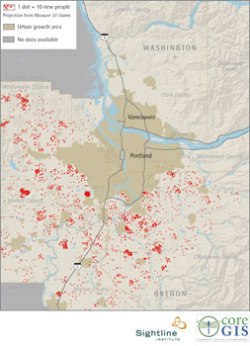In our newest edition of the Cascadia Scorecard (released yesterday), we examine one of the most important trends in the region: sprawl. It’s an area where there’s been a surprising reversal of fortune. Oregon, long a regional and national leader in smart growth, is losing its lead.
According to a new Sightline analysis, in the Portland metro region alone more than 2,000 residential applications for Measure 37 waivers were approved. Together, these claims could add nearly 14,000 housing units and, based on prevailing rates of occupancy, up to 36,000 new residents outside of growth boundaries.
[One red dot represents 10 potential new people outside of growth boundaries, based on claims from 2004 to 2006.]
Such poorly planned sprawl has not been typical of Oregon. The state has a well-deserved reputation for successful growth management; and in every previous edition of Cascadia Scorecard — not to mention numerous other Sightline studies—we’ve highlighted Oregon’s success at curbing sprawl and preserving farms and forests.
In fact, in the very first edition of the Scorecard, in 2004, we specifically contrasted ex-urban residential sprawl in Clark County, Washington (home to Vancouver, WA) to the Oregon counties of metro Portland. The difference was profound.
[One purple dot represents 10 new people outside of growth boundaries, 1990 to 2000.]
In just two years of Measure 37 enough claims were approved in the greater Portland area to potentially result in nearly as much low-density, exurban sprawl as Clark County, Washington, endured in the entire decade of the 1990s.
Free downloads of these images are available here and here, and in larger sizes too.
Plus, we’ve got a nifty side-by-side comparison of the two maps here.











a-kos
Hopefully there will be a revised version of M-37 that will greatly limit the destructive scope of the original. The legislature is likely to put in the Nov ballot and indications are it will pass (polls indicate most OR voters are unhappy with the effects of M-37).
Eric de Place
a-kos,Stay tuned. I’ll be covering the referendum on this blog and informing/tormenting readers with my Ahab-like obsession about regulatory takings laws.
Dan
Good, because at least one of your readers is similarly obsessed.;o)
ilie
For more information on who filed claims, for how much, with locations and maps, check out my site:www.measure37watch.com